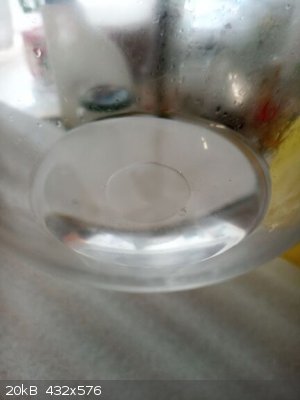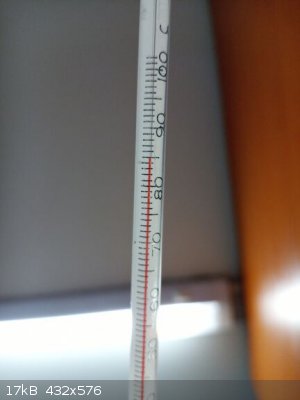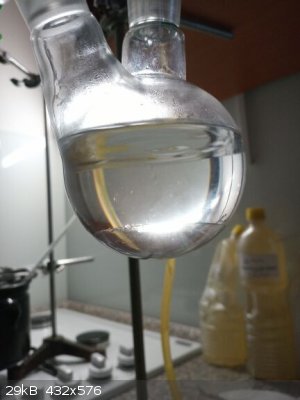Fery
International Hazard
    
Posts: 1026
Registered: 27-8-2019
Location: Czechoslovakia
Member Is Offline
|
|
n-propyl acetate - pear essence - esterification by reactive distillation
Initially the reactants were calculated as:
2 mol 1-propanol M=60,01 g/mol, 120,0 g
3 mol acetic acid M=60,05 g/mol, from which 1 mol (60,1 g) placed into reactor and 2 mols (120,1 g) mixed with alcohol and put into separatory funnel.
5 ml conc H2SO4 as a catalyst put dropwise into the 1 mol of acetic acid into the reactor flask.
The reactor containing 1 mol of acetic acid + 5 ml conc H2SO4 was heated in oil bath with oil temperature 110 C and dropping a mixture of reactants (2
mol propanol + 2 mol acetic acid) from funnel into it started at a rate approx 1 drop per 1 second. After half an hour the T of oil bath was increased
to 140 C at which the ester started to distill and the rate of drops of reactants from funnel adjusted to the rate of drops of the ester from the
condenser. Depending on the level of oil in bath and the level of mixture in the reactor heating and oil bath temperature adjusted so ester distilled
and the T in the head registered T at most 85 C. The addition lasted 3 hours (btw the back flow from Vigreaux column insulated with 5 turns of
newspaper into the reactor was somewhat higher than the rate of distillate coming from the condenser - even the drops from column overcounted drops
from condenser and there was also additionally some back flow on the colum wall) and then further distillation still produced some ester for 1 hour.
After that the T in the distillation head rose above 85 C.
The whole destillate below 85 C was poured from the receiving flask into 500 ml separatory funnel attached to lab stand and kept aside - slightly less
than 200 ml of ester fraction 1 as upper layer and 35 ml of lower layer. Lower layer drained from separatory funnel and salted out with excess of
K2CO3 which separated only 2-3 ml of upper layer (1-propanol + ester) which was discarded (if a lot of propanol obtained it would be worth of returing
it back into the reactor flask.)
Fraction 2 of volume 30 ml collected when T in head recorded 85-100 C. Treated in 250 ml Erlenmeyer flask with conc. solution of NaHCO3 with massive
CO2 evolution which yielded 20 ml of ester which was added to the fraction 1 into 500 ml separatory funnel.
Ester treated in 500 ml separatory funnel with concentrated solution of NaHCO3 with massive CO2 evolution so it apparently contained a lot of acid (so
much that it had to be initially washed while the funnel attached on a lab stand and not yet shaken at all). Removing the acid was done this way: to
the 20 g NaHCO3 in 250 ml beaker was added 50 ml of H2O in which only approx 3-5 g of NaHCO3 dissolved. The solution was poured into separatory
funnel which evolved a lot of CO2 without shaking the funnel, then the bottom layer was drained back into the beaker so more bicarbonate dissolved and
then it was poured again into the separatory funnel. This was repeated approx 10 times when CO2 evolution ceased (not because of neutralization
complete but due to high Na acetate concentration which blocked further NaHCO3 dissolution). This Na acetate was drained out and fresh 50 ml H2O added
to the beaker in which NaHCO3 dissolved and the process repeated until only little of CO2 evolution. Finally the ester was shaken 2 times with 50 ml
of saturated solution of NaHCO3 in the same separatory funnel until no more CO2 evolution. Then washed once with 25 ml ice cold H2O. 175,5 g of wet
ester obtained so far (1,72 mol = 86% yield, wow !!!). Put into 250 ml stoppered flask into freezer overnigh (-18 C). Some crystallization observed
(very likely Na acetate). Allowed to warm to room temperature and dried using Na2SO4. Then put into freezer again. Decanted directly into distillation
flask through a funnel with a small cluster of cotton in stem (ester cooled down to -18 C evaporates much less than ester with room temperature).
Distilled using oil bath through 30 cm Vigreux colum, forerun 25 ml was turbid, the distillation interrupted. A water separated at the bottom of the
collector flask (although the ester previously dried) which was removed using a pipette (the volume of water was 0,6 ml). The 25 ml fraction dried
again using Na2SO4 for 1 hour, returned back into the distillation flask. Distillation resumed. Now only 10 ml of forerun, again turbid but it drove
out all water. Main fraction collected 99-102 C (b.p. lit. 102 C). Yield 145,6 g (1,43 mol). 10 ml remained in the distillation flask. It has pear
scent in low concentration, solvent like in high concentration.
azeotropes, content, boiling point:
n-propyl acetate : H2O : propanol (59,5:21:19,5) 82,2 C
n-propyl acetate : H2O (86:14) 82,4 C
n-propanol : H2O (71,7:28,3) 87,7 C
n-propyl acetate : propanol (49:51) 94,7 C
apparatus - it was slightly sloped to allow drops of alcohol+acid to fall into reaction mixture instead to the flask wall (to reduce n-propanol
evaporation), the Vigreux colum was later insulated with 5 turns of newspaper and the pot with oil bath covered with aluminium foil to reduce heat
loses

azeotrope of ester + H2O distilled, T in head upto 85 C
 
drops of water together with ester dripping into receiving flask
 
fraction 1 upto 85 C separated into less than 200 ml of ester and 35 ml of water which salted out by K2CO3 gave only little of propanol+ester (if more
obtained if would be worth of returing the n-propanol back into the reactor distillation flask)
 
fraction 2 collected while T in head above 85 C

final step - distillation of the product, main fraction collected 99-102 C

|
|
|
Cou
National Hazard
   
Posts: 958
Registered: 16-5-2013
Member Is Offline
Mood: Mad Scientist
|
|
As someone who likes esters, I only became truly scared of coronavirus when I found out that it can cause permanent loss of smell.
|
|
|
Bedlasky
International Hazard
    
Posts: 1242
Registered: 15-4-2019
Location: Period 5, group 6
Member Is Offline
Mood: Volatile
|
|
Nice writeup! You exactly know what I am plan to do  . This ester is on my list
what I want to try to make. . This ester is on my list
what I want to try to make.
|
|
|
|